Class 12: Maths Chapter 5 solutions. Complete Class 12 Maths Chapter 5 Notes.
Contents
RD Sharma Solutions for Class 12 Maths Chapter 5–Algebra of Matrices
RD Sharma 12th Maths Chapter 5, Class 12 Maths Chapter 5 solutions
Exercise 5.1 Page No: 5.6
1. If a matrix has 8 elements, what are the possible orders it can have? What if it has 5 elements?
Solution:
If a matrix is of order m × n elements, it has m n elements. So, if the matrix has 8 elements, we will find the ordered pairs m and n.
m n = 8
Then, ordered pairs m and n will be
m × n be (8 × 1),(1 × 8),(4 × 2),(2 × 4)
Now, if it has 5 elements
Possible orders are (5 × 1), (1 × 5).

Solution:
(i)
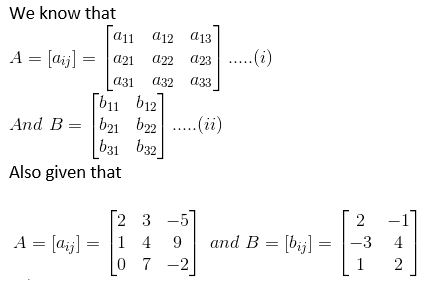
Now, Comparing with equation (1) and (2)
a22 = 4 and b21 = – 3
a22 + b21 = 4 + (– 3) = 1
(ii)

Now, Comparing with equation (1) and (2)
a11 = 2, a22 = 4, b11 = 2, b22 = 4
a11 b11 + a22 b22 = 2 × 2 + 4 × 4 = 4 + 16 = 20
3. Let A be a matrix of order 3 × 4. If R1 denotes the first row of A and C2 denotes its second column, then determine the orders of matrices R1 and C2.
Solution:
Given A be a matrix of order 3 × 4.
So, A = [ai j] 3×4
R1 = first row of A = [a11, a12, a13, a14]
So, order of matrix R1 = 1 × 4
C2 = second column of

Therefore order of C2 = 3 × 1
4. Construct a 2 ×3 matrix A = [aj j] whose elements aj j are given by:
(i) ai j = i × j
(ii) ai j = 2i – j
(iii) ai j = i + j
(iv) ai j = (i + j)2/2
Solution:
(i) Given ai j = i × j
Let A = [ai j]2 × 3
So, the elements in a 2 × 3 matrix are[a11, a12, a13, a21, a22, a23]

a11 = 1 × 1 = 1
a12 = 1 × 2 = 2
a13 = 1 × 3 = 3
a21 = 2 × 1 = 2
a22 = 2 × 2 = 4
a23 = 2 × 3 = 6
Substituting these values in matrix A we get,

(ii) Given ai j = 2i – j
Let A = [ai j]2×3
So, the elements in a 2 × 3 matrix are
a11, a12, a13, a21, a22, a23

a11 = 2 × 1 – 1 = 2 – 1 = 1
a12 = 2 × 1 – 2 = 2 – 2 = 0
a13 = 2 × 1 – 3 = 2 – 3 = – 1
a21 = 2 × 2 – 1 = 4 – 1 = 3
a22 = 2 × 2 – 2 = 4 – 2 = 2
a23 = 2 × 2 – 3 = 4 – 3 = 1
Substituting these values in matrix A we get,

(iii) Given ai j = i + j
Let A = [a i j] 2×3
So, the elements in a 2 × 3 matrix are
a11, a12, a13, a21, a22, a23

a11 = 1 + 1 = 2
a12 = 1 + 2 = 3
a13 = 1 + 3 = 4
a21 = 2 + 1 = 3
a22 = 2 + 2 = 4
a23 = 2 + 3 = 5
Substituting these values in matrix A we get,
(iv) Given ai j = (i + j)2/2
Let A = [ai j]2×3
So, the elements in a 2 × 3 matrix are
a11, a12, a13, a21, a22, a23

Let A = [ai j]2×3
So, the elements in a 2 × 3 matrix are
a11, a12, a13, a21, a22, a23

a11 =

a12 =

a13 =

a21 =

a22 =

a23 =

Substituting these values in matrix A we get,


5. Construct a 2 × 2 matrix A = [ai j] whose elements ai j are given by:
(i) (i + j)2 /2
(ii) ai j = (i – j)2 /2
(iii) ai j = (i – 2j)2 /2
(iv) ai j = (2i + j)2 /2
(v) ai j = |2i – 3j|/2
(vi) ai j = |-3i + j|/2
(vii) ai j = e2ix sin x j
Solution:
(i) Given (i + j)2 /2
Let A = [ai j]2×2
So, the elements in a 2 × 2 matrix are
a11, a12, a21, a22

a11 =

a12 =

a21 =

a22 =

Substituting these values in matrix A we get,


(ii) Given ai j = (i – j)2 /2
Let A = [ai j]2×2
So, the elements in a 2 × 2 matrix are
a11, a12, a21, a22

a11 =

a12 =

a21 =

a22 =

Substituting these values in matrix A we get,


(iii) Given ai j = (i – 2j)2 /2
Let A = [ai j]2×2
So, the elements in a 2 × 2 matrix are
a11, a12, a21, a22

a11 =

a12 =

a21 =

a22 =

Substituting these values in matrix A we get,


(iv) Given ai j = (2i + j)2 /2
Let A = [ai j]2×2
So, the elements in a 2 × 2 matrix are
a11, a12, a21, a22

a11 =

a12 =

a21 =

a22 =

Substituting these values in matrix A we get,


(v) Given ai j = |2i – 3j|/2
Let A = [ai j]2×2
So, the elements in a 2×2 matrix are
a11, a12, a21, a22

a11 =

a12 =

a21 =

a22 =

Substituting these values in matrix A we get,


(vi) Given ai j = |-3i + j|/2
Let A = [ai j]2×2
So, the elements in a 2 × 2 matrix are
a11, a12, a21, a22

a11 =

a12 =

a21 =

a22 =

Substituting these values in matrix A we get,


(vii) Given ai j = e2ix sin x j
Let A = [ai j]2×2
So, the elements in a 2 × 2 matrix are
a11, a12, a21, a22,

a11 =

a12 =

a21 =

a22 =

Substituting these values in matrix A we get,

6. Construct a 3×4 matrix A = [ai j] whose elements ai j are given by:
(i) ai j = i + j
(ii) ai j = i – j
(iii) ai j = 2i
(iv) ai j = j
(v) ai j = ½ |-3i + j|
Solution:
(i) Given ai j = i + j
Let A = [ai j]2×3
So, the elements in a 3 × 4 matrix are
a11, a12, a13, a14, a21, a22, a23, a24, a31, a32, a33, a34
A =

a11 = 1 + 1 = 2
a12 = 1 + 2 = 3
a13 = 1 + 3 = 4
a14 = 1 + 4 = 5
a21 = 2 + 1 = 3
a22 = 2 + 2 = 4
a23 = 2 + 3 = 5
a24 = 2 + 4 = 6
a31 = 3 + 1 = 4
a32 = 3 + 2 = 5
a33 = 3 + 3 = 6
a34 = 3 + 4 = 7
Substituting these values in matrix A we get,
A =


(ii) Given ai j = i – j
Let A = [ai j]2×3
So, the elements in a 3×4 matrix are
a11, a12, a13, a14, a21, a22, a23, a24, a31, a32, a33, a34
A =

a11 = 1 – 1 = 0
a12 = 1 – 2 = – 1
a13 = 1 – 3 = – 2
a14 = 1 – 4 = – 3
a21 = 2 – 1 = 1
a22 = 2 – 2 = 0
a23 = 2 – 3 = – 1
a24 = 2 – 4 = – 2
a31 = 3 – 1 = 2
a32 = 3 – 2 = 1
a33 = 3 – 3 = 0
a34 = 3 – 4 = – 1
Substituting these values in matrix A we get,
A =


(iii) Given ai j = 2i
Let A = [ai j]2×3
So, the elements in a 3×4 matrix are
a11, a12, a13, a14, a21, a22, a23, a24, a31, a32, a33, a34
A =

a11 = 2×1 = 2
a12 = 2×1 = 2
a13 = 2×1 = 2
a14 = 2×1 = 2
a21 = 2×2 = 4
a22 = 2×2 = 4
a23 = 2×2 = 4
a24 = 2×2 = 4
a31 = 2×3 = 6
a32 = 2×3 = 6
a33 = 2×3 = 6
a34 = 2×3 = 6
Substituting these values in matrix A we get,
A =


(iv) Given ai j = j
Let A = [ai j]2×3
So, the elements in a 3×4 matrix are
a11, a12, a13, a14, a21, a22, a23, a24, a31, a32, a33, a34
A =

a11 = 1
a12 = 2
a13 = 3
a14 = 4
a21 = 1
a22 = 2
a23 = 3
a24 = 4
a31 = 1
a32 = 2
a33 = 3
a34 = 4
Substituting these values in matrix A we get,
A =


(vi) Given ai j = ½ |-3i + j|
Let A = [ai j]2×3
So, the elements in a 3×4 matrix are
a11, a12, a13, a14, a21, a22, a23, a24, a31, a32, a33, a34
A =

a11 =

a12 =

a13 =

a14 =

a21 =

a22 =

a23 =

a24 =

a31 =

a32 =

a33 =

a34 =

Substituting these values in matrix A we get,
A =

Multiplying by negative sign we get,
7. Construct a 4 × 3 matrix A = [ai j] whose elements ai j are given by:
(i) ai j = 2i + i/j
(ii) ai j = (i – j)/ (i + j)
(iii) ai j = i
Solution:
(i) Given ai j = 2i + i/j
Let A = [ai j]4×3
So, the elements in a 4 × 3 matrix are
a11, a12, a13, a21, a22, a23, a31, a32, a33, a41, a42, a43
A =

a11 =

a12 =

a13 =

a21 =

a22 =

a23 =

a31 =

a32 =

a33 =

a41 =

a42 =

a43 =

Substituting these values in matrix A we get,
A =


(ii) Given ai j = (i – j)/ (i + j)
Let A = [ai j]4×3
So, the elements in a 4 × 3 matrix are
a11, a12, a13, a21, a22, a23, a31, a32, a33, a41, a42, a43
A =

a11 =

a12 =

a13 =

a21 =

a22 =

a23 =

a31 =

a32 =

a33 =

a41 =

a42 =

a43 =

Substituting these values in matrix A we get,
A =


(iii) Given ai j = i
Let A = [ai j]4×3
So, the elements in a 4 × 3 matrix are
a11, a12, a13, a21, a22, a23, a31, a32, a33, a41, a42, a43
A =

a11 = 1
a12 = 1
a13 = 1
a21 = 2
a22 = 2
a23 = 2
a31 = 3
a32 = 3
a33 = 3
a41 = 4
a42 = 4
a43 = 4
Substituting these values in matrix A we get,
A =


8. Find x, y, a and b if

Solution:
Given

Given that two matrices are equal.
We know that if two matrices are equal then the elements of each matrices are also equal.
Therefore by equating them we get,
3x + 4y = 2 …… (1)
x – 2y = 4 …… (2)
a + b = 5 …… (3)
2a – b = – 5 …… (4)
Multiplying equation (2) by 2 and adding to equation (1), we get
3x + 4y + 2x – 4y = 2 + 8
⇒ 5x = 10
⇒ x = 2
Now, substituting the value of x in equation (1)
3 × 2 + 4y = 2
⇒ 6 + 4y = 2
⇒ 4y = 2 – 6
⇒ 4y = – 4
⇒ y = – 1
Now by adding equation (3) and (4)
a + b + 2a – b = 5 + (– 5)
⇒ 3a = 5 – 5 = 0
⇒ a = 0
Now, again by substituting the value of a in equation (3), we get
0 + b = 5
⇒ b = 5
∴ a = 0, b = 5, x = 2 and y = – 1
9. Find x, y, a and b if

Solution:

We know that if two matrices are equal then the elements of each matrices are also equal.
Given that two matrices are equal.
Therefore by equating them we get,
2a + b = 4 …… (1)
And a – 2b = – 3 …… (2)
And 5c – d = 11 …… (3)
4c + 3d = 24 …… (4)
Multiplying equation (1) by 2 and adding to equation (2)
4a + 2b + a – 2b = 8 – 3
⇒ 5a = 5
⇒ a = 1
Now, substituting the value of a in equation (1)
2 × 1 + b = 4
⇒ 2 + b = 4
⇒ b = 4 – 2
⇒ b = 2
Multiplying equation (3) by 3 and adding to equation (4)
15c – 3d + 4c + 3d = 33 + 24
⇒ 19c = 57
⇒ c = 3
Now, substituting the value of c in equation (4)
4 × 3 + 3d = 24
⇒ 12 + 3d = 24
⇒ 3d = 24 – 12
⇒ 3d = 12
⇒ d = 4
∴ a = 1, b = 2, c = 3 and d = 4
10. Find the values of a, b, c and d from the following equations:

Solution:
Given

We know that if two matrices are equal then the elements of each matrices are also equal.
Given that two matrices are equal.
Therefore by equating them we get,
2a + b = 4 …… (1)
And a – 2b = – 3 …… (2)
And 5c – d = 11 …… (3)
4c + 3d = 24 …… (4)
Multiplying equation (1) by 2 and adding to equation (2)
4a + 2b + a – 2b = 8 – 3
⇒ 5a = 5
⇒ a = 1
Now, substituting the value of a in equation (1)
2 × 1 + b = 4
⇒ 2 + b = 4
⇒ b = 4 – 2
⇒ b = 2
Multiplying equation (3) by 3 and adding to equation (4)
15c – 3d + 4c + 3d = 33 + 24
⇒ 19c = 57
⇒ c = 3
Now, substituting the value of c in equation (4)
4 × 3 + 3d = 24
⇒ 12 + 3d = 24
⇒ 3d = 24 – 12
⇒ 3d = 12
⇒ d = 4
∴ a = 1, b = 2, c = 3 and d = 4
Exercise 5.2 Page No: 5.18
1. Compute the following sums:


Solution:
(i) Given

Corresponding elements of two matrices should be added
Therefore, we get
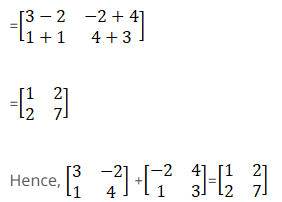
Therefore,

(ii) Given



Therefore,


Find each of the following:
(i) 2A – 3B
(ii) B – 4C
(iii) 3A – C
(iv) 3A – 2B + 3C
Solution:
(i) Given

First we have to compute 2A

Now by computing 3B we get,

Now by we have to compute 2A – 3B we get
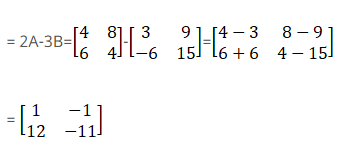
Therefore

(ii) Given

First we have to compute 4C,

Now,

Therefore we get,

(iii) Given

First we have to compute 3A,

Now,

Therefore,

(iv) Given

First we have to compute 3A

Now we have to compute 2B

By computing 3C we get,


Therefore,


(i) A + B and B + C
(ii) 2B + 3A and 3C – 4B
Solution:
(i) Consider A + B,
A + B is not possible because matrix A is an order of 2 x 2 and Matrix B is an order of 2 x 3, so the Sum of the matrix is only possible when their order is same.
Now consider B + C
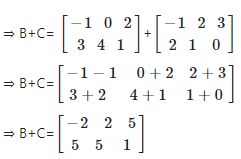
(ii) Consider 2B + 3A
2B + 3A also does not exist because the order of matrix B and matrix A is different, so we cannot find the sum of these matrix.
Now consider 3C – 4B,


Solution:
Given

Now we have to compute 2A – 3B + 4C

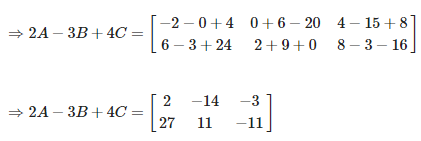
5. If A = diag (2 -5 9), B = diag (1 1 -4) and C = diag (-6 3 4), find
(i) A – 2B
(ii) B + C – 2A
(iii) 2A + 3B – 5C
Solution:
(i) Given A = diag (2 -5 9), B = diag (1 1 -4) and C = diag (-6 3 4)
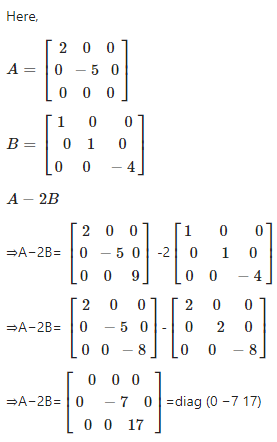
(ii) Given A = diag (2 -5 9), B = diag (1 1 -4) and C = diag (-6 3 4)
We have to find B + C – 2A
Here,

Now we have to compute B + C – 2A

(iii) Given A = diag (2 -5 9), B = diag (1 1 -4) and C = diag (-6 3 4)
Now we have to find 2A + 3B – 5C
Here,
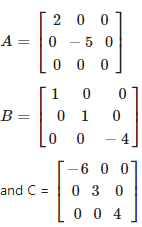
Now consider 2A + 3B – 5C
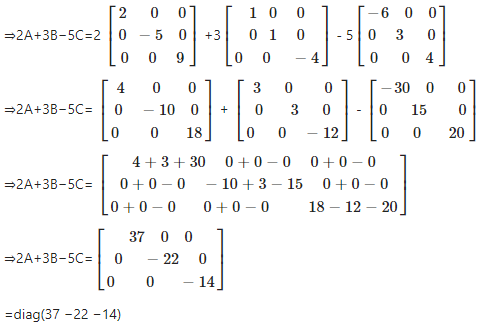
6. Given the matrices

Verify that (A + B) + C = A + (B + C)
Solution:
Given

Now we have to verify (A + B) + C = A + (B + C)
First consider LHS, (A + B) + C,
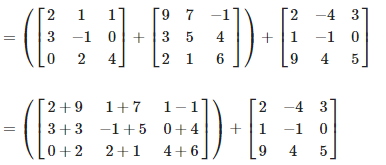

Now consider RHS, that is A + (B + C)
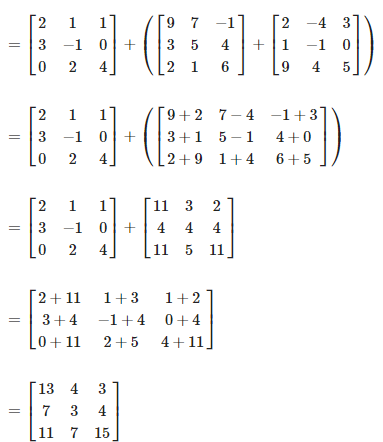
Therefore LHS = RHS
Hence (A + B) + C = A + (B + C)
7. Find the matrices X and Y,

Solution:
Consider,

Now by simplifying we get,
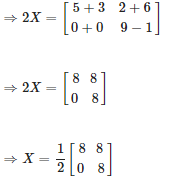
Therefore,

Again consider,
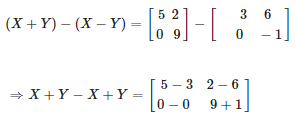
Now by simplifying we get,

Therefore,


Solution:
Given

Now by transposing, we get

Therefore,


Solution:
Given


Now by multiplying equation (1) and (2) we get,


Now by adding equation (2) and (3) we get,

Now by substituting X in equation (2) we get,
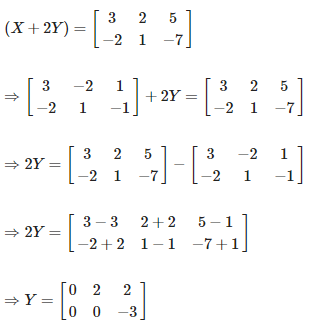

Solution:
Consider
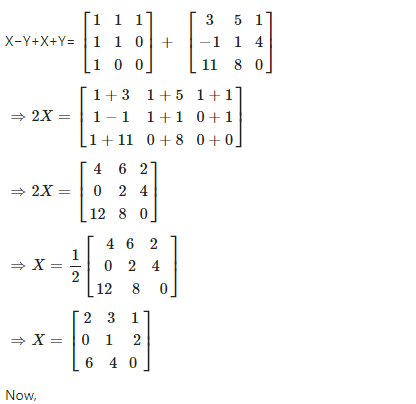
Now, again consider

Therefore,

And

Exercise 5.3 Page No: 5.41
1. Compute the indicated products:



Solution:
(i) Consider

On simplification we get,

(ii) Consider

On simplification we get,

(iii) Consider

On simplification we get,

2. Show that AB ≠ BA in each of the following cases:



Solution:
(i) Consider,

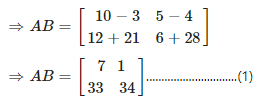
Again consider,
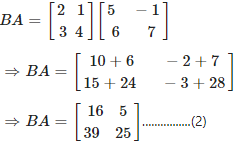
From equation (1) and (2), it is clear that
AB ≠ BA
(ii) Consider,
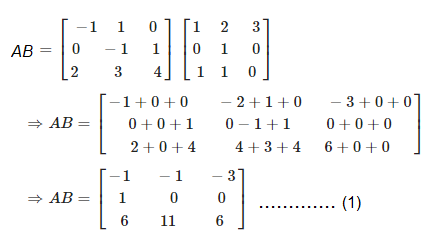
Now again consider,
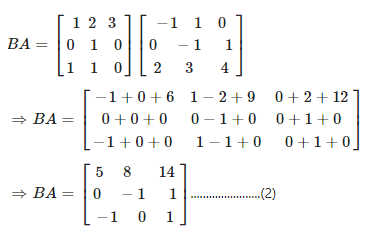
From equation (1) and (2), it is clear that
AB ≠ BA
(iii) Consider,

Now again consider,
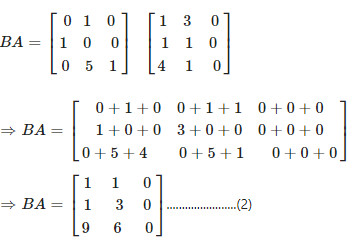
From equation (1) and (2), it is clear that
AB ≠ BA
3. Compute the products AB and BA whichever exists in each of the following cases:




Solution:
(i) Consider,
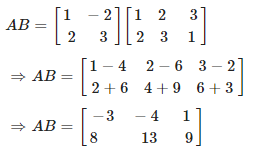
BA does not exist
Because the number of columns in B is greater than the rows in A
(ii) Consider,
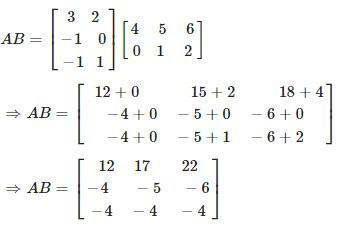
Again consider,

(iii) Consider,
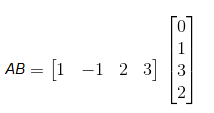
AB = [0 + (-1) + 6 + 6]
AB = 11
Again consider,
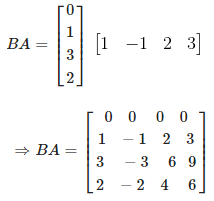
(iv) Consider,


4. Show that AB ≠ BA in each of the following cases:

Solution:
(i) Consider,
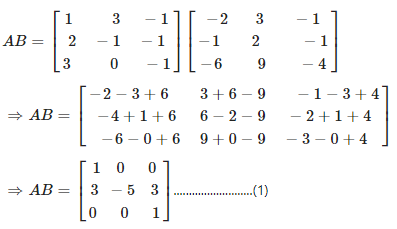
Again consider,
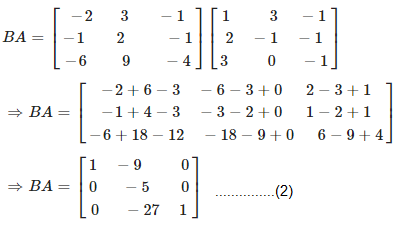
From equation (1) and (2), it is clear that
AB ≠ BA
(ii) Consider,
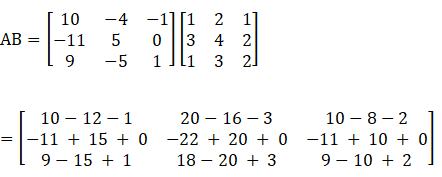

Again consider,
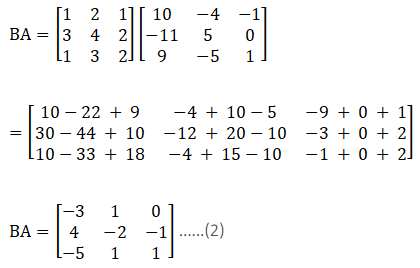
From equation (1) and (2) it is clear that,
AB ≠ BA
5. Evaluate the following:



Solution:
(i) Given

First we have to add first two matrix,
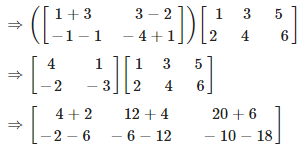
On simplifying, we get

(ii) Given,

First we have to multiply first two given matrix,
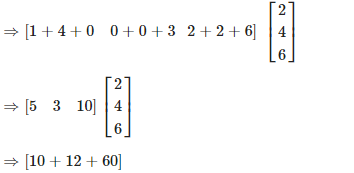
= 82
(iii) Given

First we have subtract the matrix which is inside the bracket,



Solution:
Given

We know that,
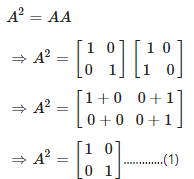
Again we know that,
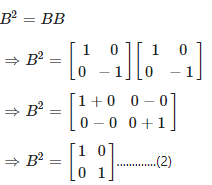
Now, consider,
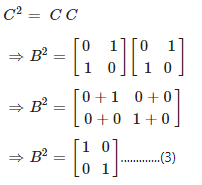
We have,

Now, from equation (1), (2), (3) and (4), it is clear that A2 = B2= C2= I2

Solution:
Given

Consider,
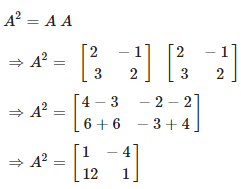
Now we have to find,



Solution:
Given

Consider,
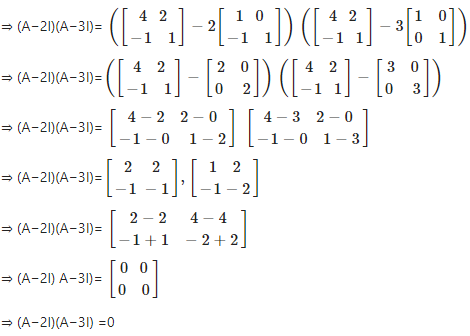
Hence the proof.

Solution:
Given,

Consider,
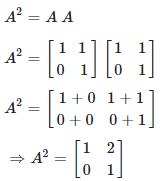
Again consider,
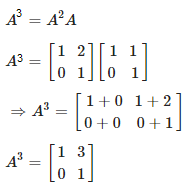
Hence the proof.

Solution:
Given,

Consider,
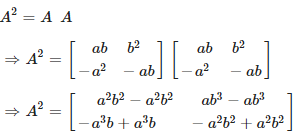

Hence the proof.

Solution:
Given,

Consider,

We know that,


Again we have,



Solution:
Given,

Consider,
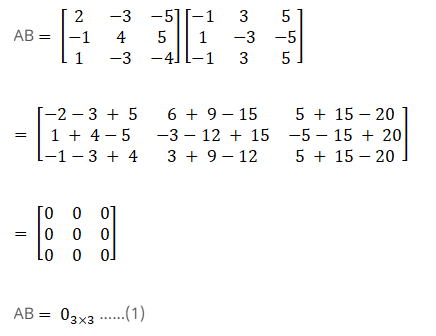
Again consider,
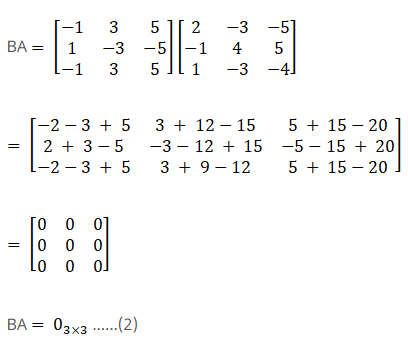
From equation (1) and (2) AB = BA = 03×3

Solution:
Given

Consider,
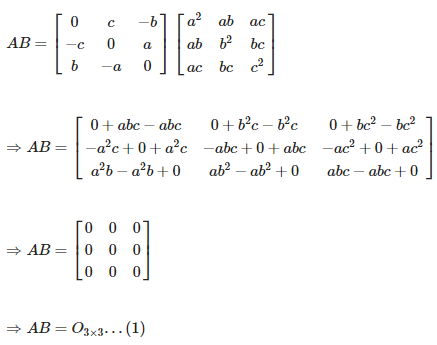
Again consider,
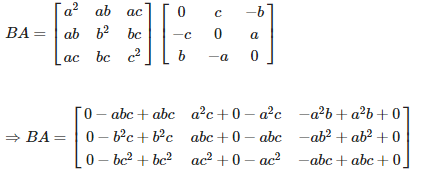
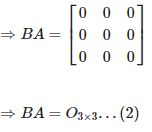
From equation (1) and (2) AB = BA = 03×3

Solution:
Given

Now consider,
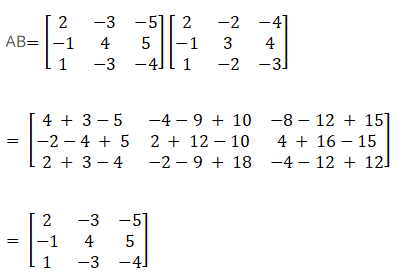
Therefore AB = A
Again consider, BA we get,

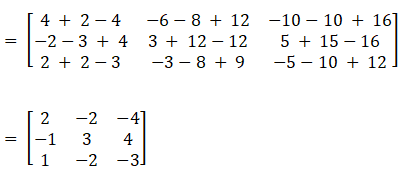
Hence BA = B
Hence the proof.

Solution:
Given,

Consider,
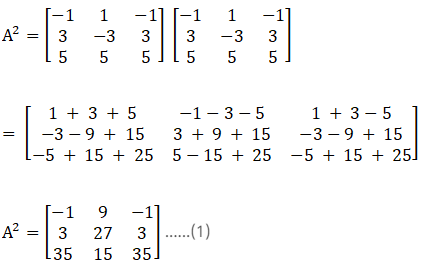
Now again consider, B2

Now by subtracting equation (2) from equation (1) we get,
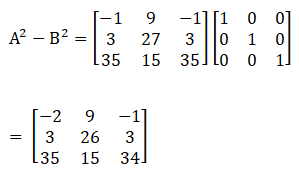
16. For the following matrices verify the associativity of matrix multiplication i.e. (AB) C = A (BC)


Solution:
(i) Given

Consider,
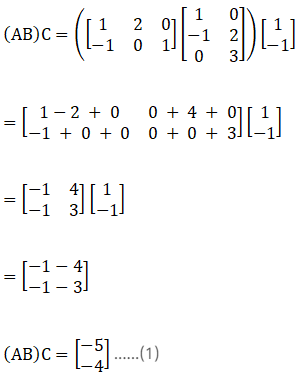
Now consider RHS,
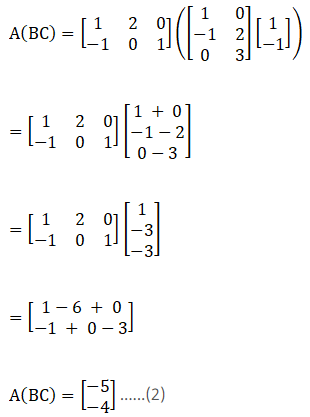
From equation (1) and (2), it is clear that (AB) C = A (BC)
(ii) Given,

Consider the LHS,

Now consider RHS,
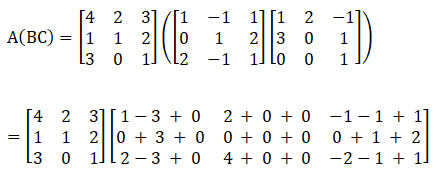

From equation (1) and (2), it is clear that (AB) C = A (BC)
17. For the following matrices verify the distributivity of matrix multiplication over matrix addition i.e. A (B + C) = AB + AC.


Solution:
(i) Given

Consider LHS,
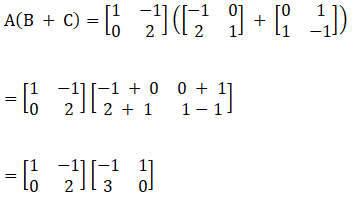

Now consider RHS,
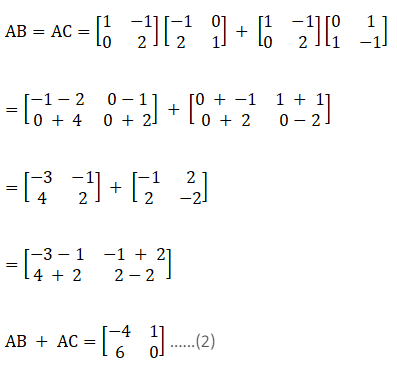
From equation (1) and (2), it is clear that A (B + C) = AB + AC
(ii) Given,

Consider the LHS
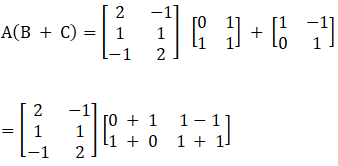
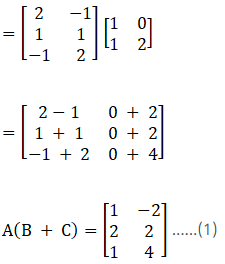
Now consider RHS,
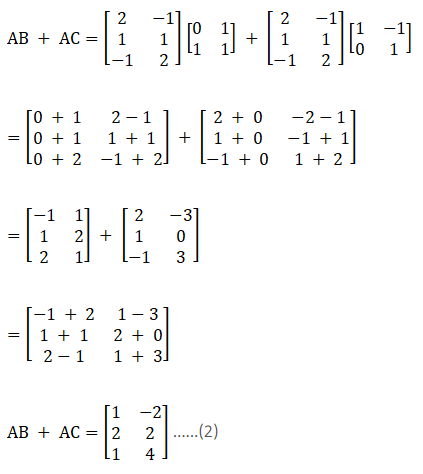


Solution:
Given,

Consider the LHS,
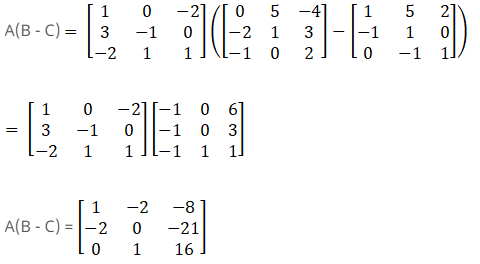
Now consider RHS
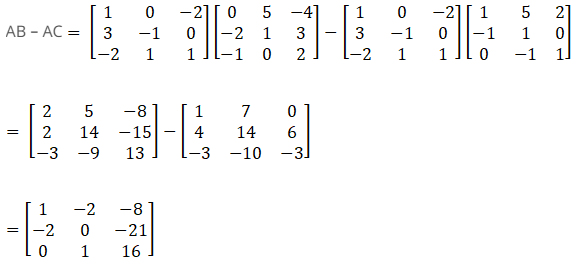
From the above equations LHS = RHS
Therefore, A (B – C) = AB – AC.
19. Compute the elements a43 and a22 of the matrix:

Solution:
Given

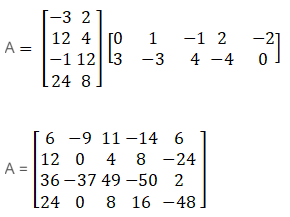
From the above matrix, a43 = 8and a22 = 0

Solution:
Given

Consider,
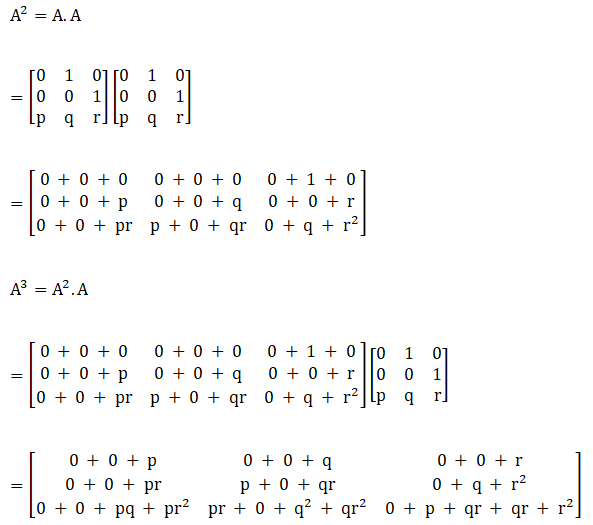
Again consider,
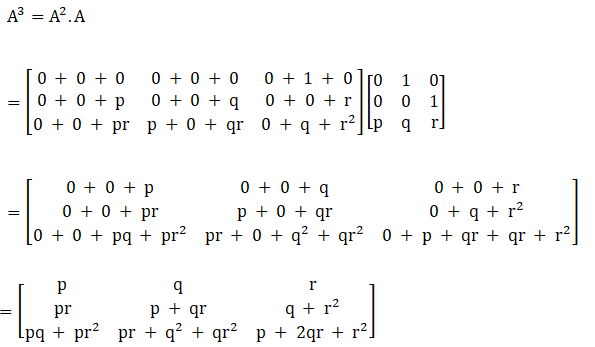
Now, consider the RHS


Therefore, A3 = p I + q A + rA2
Hence the proof.
21. If ω is a complex cube root of unity, show that

Solution:
Given

It is also given that ω is a complex cube root of unity,
Consider the LHS,

We know that 1 + ω + ω2 = 0 and ω3 = 1

Now by simplifying we get,

Again by substituting 1 + ω + ω2 = 0 and ω3 = 1 in above matrix we get,

Therefore LHS = RHS
Hence the proof.
Solution:
Given,

Consider A2
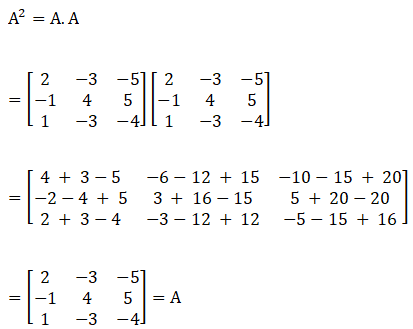
Therefore A2 = A

Solution:
Given

Consider A2,
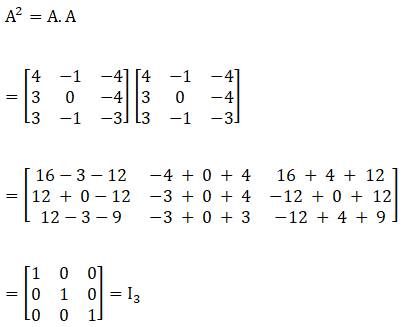
Hence A2 = I3

Solution:
(i) Given

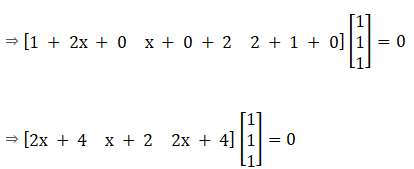
= [2x + 1 + 2 + x + 3] = 0
= [3x + 6] = 0
= 3x = -6
x = -6/3
x = -2
(ii) Given,


On comparing the above matrix we get,
x = 13

Solution:
Given


⇒ [(2x + 4) x + 4 (x + 2) – 1(2x + 4)] = 0
⇒ 2x2 + 4x + 4x + 8 – 2x – 4 = 0
⇒ 2x2 + 6x + 4 = 0
⇒ 2x2 + 2x + 4x + 4 = 0
⇒ 2x (x + 1) + 4 (x + 1) = 0
⇒ (x + 1) (2x + 4) = 0
⇒ x = -1 or x = -2
Hence, x = -1 or x = -2

Solution:
Given

By multiplying we get,



Solution:
Given

Now we have to prove A2 – A + 2 I = 0
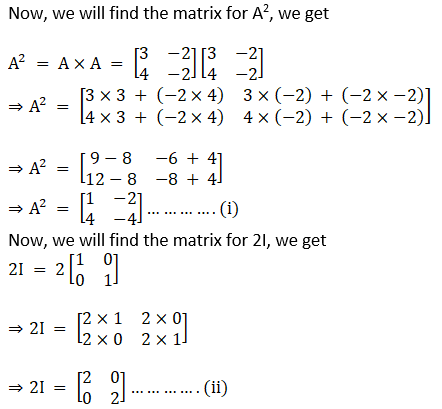
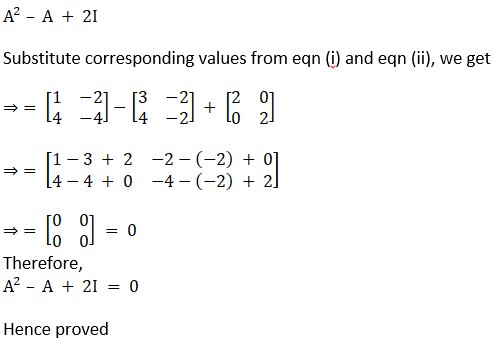

Solution:
Given


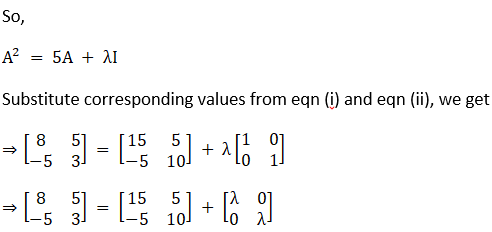


Solution:
Given

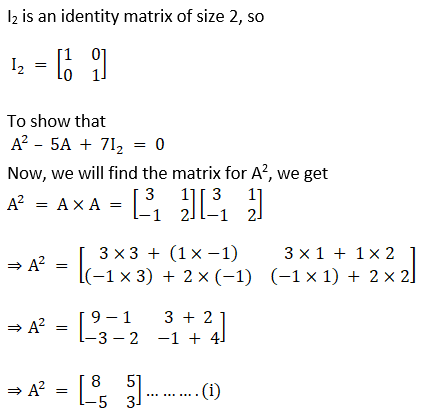
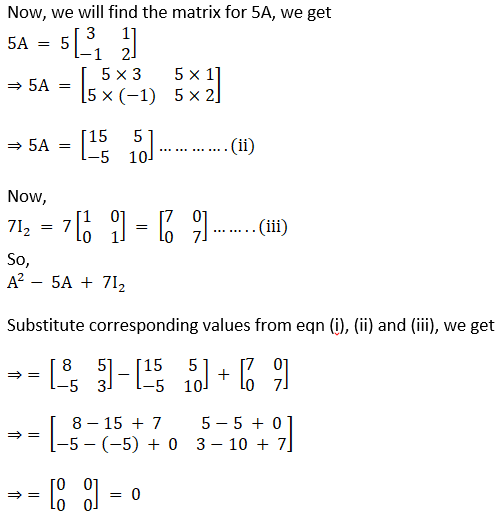
Hence the proof.

Solution:
Given




Hence the proof.

Solution:
Given

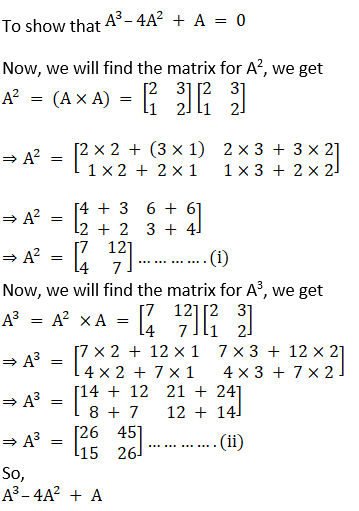



Solution:
Given

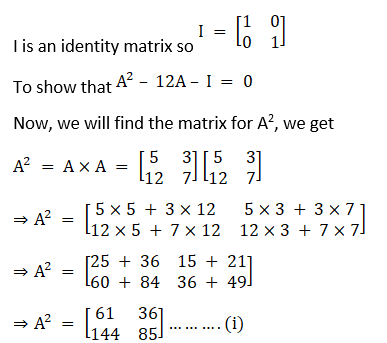


Solution:
Given



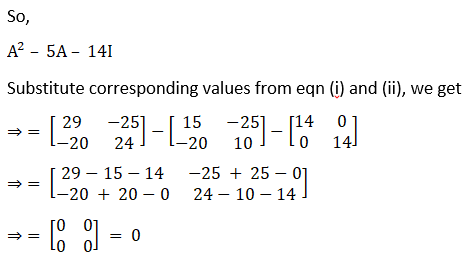

Solution:
Given



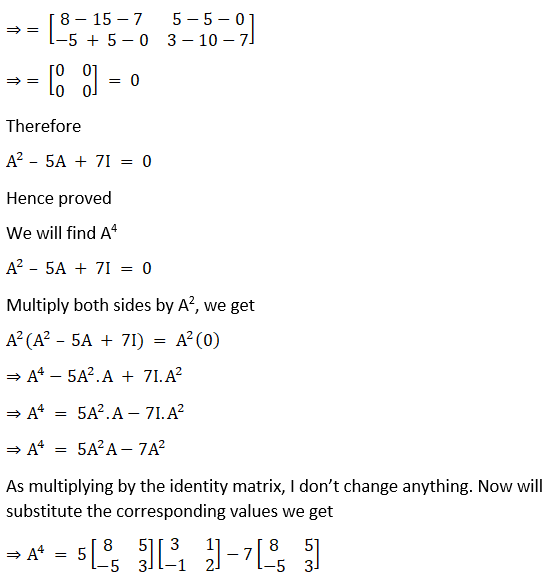
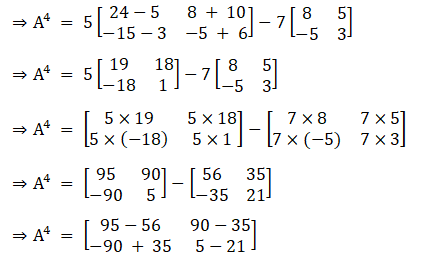


Solution:
Given

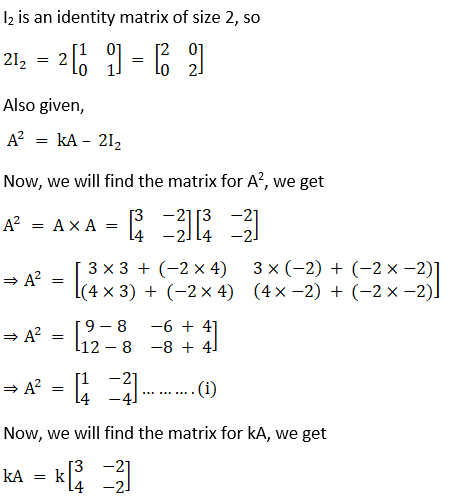

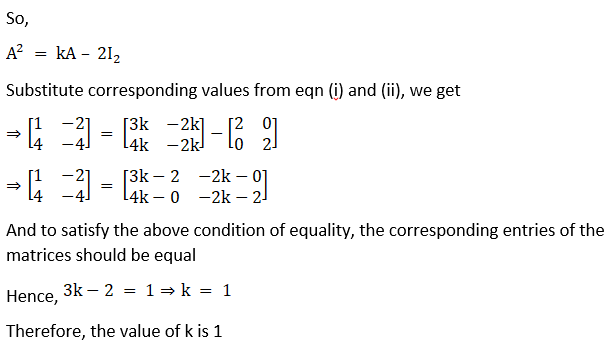

Solution:
Given

I is identity matrix, so

Also given,

Now, we have to find A2, we get



Now, we will find the matrix for 8A, we get



So,

Substitute corresponding values from eqn (i) and (ii), we get


And to satisfy the above condition of equality, the corresponding entries of the matrices should be equal
Hence,

Therefore, the value of k is 7

Solution:
Given

To show that f (A) = 0
Substitute x = A in f(x), we get

I is identity matrix, so

Now, we will find the matrix for A2, we get




Now, we will find the matrix for 2A, we get



Substitute corresponding values from eqn (ii) and (iii) in eqn (i), we get




So,

Hence Proved

Solution:
Given

So

Now, we will find the matrix for A2, we get



Now, we will find the matrix for λ A, we get



But given, A2 = λ A + μ I
Substitute corresponding values from equation (i) and (ii), we get


And to satisfy the above condition of equality, the corresponding entries of the matrices should be equal
Hence, λ + 0 = 4 ⇒ λ = 4
And also, 2λ + μ = 7
Substituting the obtained value of λ in the above equation, we get
2(4) + μ = 7 ⇒ 8 + μ = 7 ⇒ μ = – 1
Therefore, the value of λ and μ are 4 and – 1 respectively
39. Find the value of x for which the matrix product

Solution:
We know,

is identity matrix of size 3.
So according to the given criteria

Now we will multiply the two matrices on LHS using the formula cij = ai1b1j + ai2b2j + … + ain bnj, we get


And to satisfy the above condition of equality, the corresponding entries of the matrices should be equal
So we get

So the value of x is

Exercise 5.4 Page No: 5.54

(i) (2A)T = 2 AT
(ii) (A + B)T = AT + BT
(iii) (A – B)T = AT – BT
(iv) (AB)T = BT AT
Solution:
(i) Given

Consider,

Put the value of A



L.H.S = R.H.S
(ii) Given

Consider,





L.H.S = R.H.S
Hence proved.
(iii) Given

Consider,





L.H.S = R.H.S
(iv) Given






So,


Solution:
Given





L.H.S = R.H.S
So,


(i) A + B)T = AT + BT
(ii) (AB)T = BT AT
(iii) (2A)T = 2 AT
Solution:
(i) Given

Consider,





L.H.S = R.H.S
So,

(ii) Given

Consider,





L.H.S = R.H.S
So,

(iii) Given

Consider,




L.H.S = R.H.S
So,


Solution:
Given

Consider,




L.H.S = R.H.S
So,


Solution:
Given

Now we have to find (AB)T




So,

Exercise 5.5 Page No: 5.60

Solution:
Given

Consider,




… (i)



… (ii)
From (i) and (ii) we can see that
A skew-symmetric matrix is a square matrix whose transpose equal to its negative, that is,
X = – XT
So, A – AT is a skew-symmetric.

Solution:
Given

Consider,

… (i)



… (ii)
From (i) and (ii) we can see that
A skew-symmetric matrix is a square matrix whose transpose equals its negative, that is,
X = – XT
So, A – AT is a skew-symmetric matrix.

Solution:
Given,

is a symmetric matrix.
We know that A = [aij]m × n is a symmetric matrix if aij = aji
So,




Hence, x = 4, y = 2, t = -3 and z can have any value.
4. Let. Find matrices X and Y such that X + Y = A, where X is a symmetric and y is a skew-symmetric matrix.
Solution:
Given,

Then





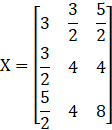
Now,




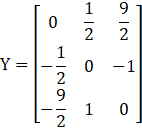
Now,
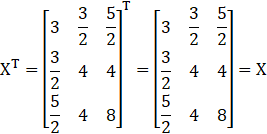
X is a symmetric matrix.
Now,

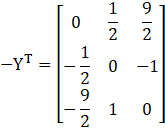
-Y T = Y
Y is a skew symmetric matrix.



Hence, X + Y = A
RD Sharma Solutions for Class 12 Maths Chapter 5: Download PDF
RD Sharma Solutions for Class 12 Maths Chapter 5–Algebra of Matrices
Download PDF: RD Sharma Solutions for Class 12 Maths Chapter 5–Algebra of Matrices PDF
Chapterwise RD Sharma Solutions for Class 12 Maths :
- Chapter 1–Relation
- Chapter 2–Functions
- Chapter 3–Binary Operations
- Chapter 4–Inverse Trigonometric Functions
- Chapter 5–Algebra of Matrices
- Chapter 6–Determinants
- Chapter 7–Adjoint and Inverse of a Matrix
- Chapter 8–Solution of Simultaneous Linear Equations
- Chapter 9–Continuity
- Chapter 10–Differentiability
- Chapter 11–Differentiation
- Chapter 12–Higher Order Derivatives
- Chapter 13–Derivatives as a Rate Measurer
- Chapter 14–Differentials, Errors and Approximations
- Chapter 15–Mean Value Theorems
- Chapter 16–Tangents and Normals
- Chapter 17–Increasing and Decreasing Functions
- Chapter 18–Maxima and Minima
- Chapter 19–Indefinite Integrals
About RD Sharma
RD Sharma isn’t the kind of author you’d bump into at lit fests. But his bestselling books have helped many CBSE students lose their dread of maths. Sunday Times profiles the tutor turned internet star
He dreams of algorithms that would give most people nightmares. And, spends every waking hour thinking of ways to explain concepts like ‘series solution of linear differential equations’. Meet Dr Ravi Dutt Sharma — mathematics teacher and author of 25 reference books — whose name evokes as much awe as the subject he teaches. And though students have used his thick tomes for the last 31 years to ace the dreaded maths exam, it’s only recently that a spoof video turned the tutor into a YouTube star.
R D Sharma had a good laugh but said he shared little with his on-screen persona except for the love for maths. “I like to spend all my time thinking and writing about maths problems. I find it relaxing,” he says. When he is not writing books explaining mathematical concepts for classes 6 to 12 and engineering students, Sharma is busy dispensing his duty as vice-principal and head of department of science and humanities at Delhi government’s Guru Nanak Dev Institute of Technology.
